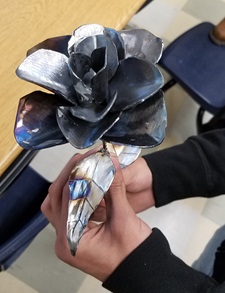Welding training
In Ivan Arroyo’s welding classroom at East Career & Technical Academy in Las Vegas, students must clock in and clock out — just as they would on the jobsite or in the fab shop.
In addition to building their welding experience, Arroyo is also trying to instill the kind of “soft skills,” like respect, professionalism and punctuality, that will help his students get jobs and keep jobs.
“I was a welding supervisor for many years at a shipyard. I teach my classes the way I used to supervise where I worked,” Arroyo says. “They have to clock in and out of their shift so they get into the habit of how the system works. You clock in, and you should be ready with your safety glasses and your boots on. If you’re working for someone and they’re paying you, you have to respect their time.”
Training new welders
East Career & Technical Academy is a magnet school focused on training high schoolers for careers in a range of industries. The school offers a total of eight programs, including construction, culinary arts, marketing and mechanical technology. While welding classes are currently offered as electives, interest is growing and Arroyo hopes welding will be a full academic program in the future.
“It’s an elective, but it’s pretty big,” Arroyo says. “We get about 200 students a year in welding.”
Multiple sessions are offered of Welding I, II and III for students at the high school. All students must start in Welding I and work their way up. The students start by learning proper safety guidelines as well as oxy-fuel and plasma cutting and stick welding. As they proceed through the classes, they cover MIG, TIG, pipe and flux-cored welding in addition to blueprint reading and OSHA standards.
The vast majority of students at the school start with no welding experience. Going to college is encouraged for students at the school — many of whom would be first-generation college students — but teachers also let students know that a college degree isn’t required to be successful in life.
Arroyo uses his own background as a success story to help motivate them. After coming to the United States from Mexico in 2004, Arroyo earned his GED and then took welding classes and earned his welding certifications, working his way up to welding supervisor at a San Diego shipyard.
“My students come in shy with little to no knowledge of welding and power tools and leave full of confidence and capability,” Arroyo says. “I tell them: Welding is a great career and you can see it everywhere you look. Give it a try and let welding change your life like it changed mine.”
Using scrap for welding projects

Working on unique projects in the welding classroom helps keep the students engaged. The school doesn’t have a lot of supplies, so welding students often use scrap metal from the auto program for their work. For Valentine’s Day, the students cut sheet metal pieces from the door of an old car in the school’s auto shop. They fabricated those pieces into metal flowers.
“I have my students remove the doors, remove the hoods, remove the paint and then they cut them up with the plasma cutter,” Arroyo says. “I want them to go through the process, and they turn scrap into art.”
In another project, students must cut out a piece of an I-beam and replace it. It involves a lot of measuring, cutting and fit-up. They have to weld from both sides (a full penetration weld) and it must pass visual inspection.
“It’s a pretty intense project, but I want them to do something they could encounter in industry,” Arroyo says.
In Arroyo’s welding classroom, students use numerous Miller® machines, including a Spectrum® 875 plasma cutter, a Millermatic® MIG welder and Dynasty® 280 TIG welder.
Welding careers
After practicing in the classroom, Arroyo’s students can earn scholarships or American Welding Society certification. They also can attend state and national competitions through SkillsUSA, which helps open doors for them.
The school is working with several local and state organizations to place students in internships and jobs in the welding industry. The school’s career services office also works to connect students with local employers.
“There are many welding processes to learn and also welding branches that will open doors,” Arroyo says. “They can go from being a welder to an engineer. You never stop learning.”